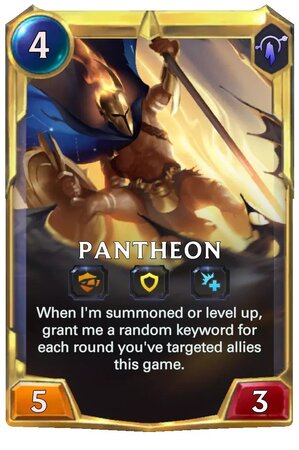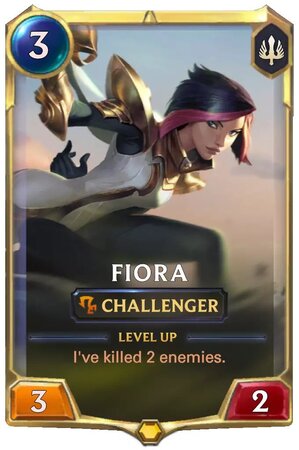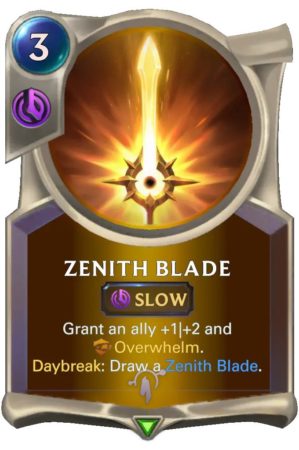How to Play: Fiora Pantheon
I know, I know, Pantheon this, Pantheon that, we’re tired of all the different Pantheon variants under the sun showing up to play.
They all run out basically the same anyway, right? Well, not quite.
I’m Jordan “WhatAmI” Abronson and I’ve finally been Pokey Sticked sufficiently about this creation to do a full deck guide on it.
While many of the key cards and factors are the same, there are enough different matchup tables and considerations in this variant that I find it quite worth checking out.

Deck Code: CECQEAIABEWQEBIABQKACAYJDMAQKCIDAEBAAAIFAMBQSIZNGMAQGAAOAEAQAGQBAUEQMAIEAABAGAQFAAHBCAQDBEJVKAIFBEFA
[See Fiora Pantheon deck details]
Fiora Pantheon
Well, that and I think that a lot of people look at how to both play and mulligan Pantheon-based decks in general quite incorrectly. What I think gets missed a lot of the time is that this deck is significantly closer in play style to Thralls or Lee than it is to basically any other Demacia variant.
This type of deck is what I like to call a “Pillar” deck, and no, not Trundle. You are looking for one of a small number of cards in your deck to hold you up while the entire rest of your deck focuses on making those cards more powerful.
In this case, we have eight Pillars, three Fiora, three Petracite Broadwing, and two Wounded Whiteflame. Pantheon can be a backup Pillar, but we do really need to be doing things by turn three for mana efficiency purposes. So, what specifically are we doing? Well-
Phase One: Selection
From the beginning, we need to be thinking about what our best pillar is in a given matchup. In general, this will be either Fiora into anything remotely aggressive, or Petricite Broadwing into anything else. It might not start out looking like all that much, but giant Overwhelm Challenger units close games remarkably quickly.

Wounded Whiteflame is there more as a backup strategy than as what we actually want to hit. The math gets a little complicated so I am not going to go all the way into it here, but suffice to say that having eight cards that let your deck play the game is *significantly* better than having merely six.
We won’t always be the happiest if we are forced to commit our resources onto the dragon lad, but there are still plenty of games where he will get the job done. The reason we’d generally not choose this one is that many of the said resources are optimized for the other two units.
Whiteflame doesn’t exactly mind getting a huge butt and becoming invincible, but he tends to do that alright on his own without help from Shield of Durand or Astral Protection. Fiora and Broadwing both flourish in environments where they simply cannot be killed by non-Vengeance conventional means.

Phase Two: Choosing the Endgame
This deck is interesting because while you have eight cards in the early game that get you running, there’s also only a small subset that will actually cause the game to end in your favor. So our next step is to, as always, define our win condition.
Some people take this as a point against Pillar decks but I’d challenge those same people to count the actual win conditions in most decks. I’d be personally surprised if you come up with a double-digit number that you can defend.
We’re no exception here, but we do pretty alright. Fiora, Zenith Blade, and Pantheon are the ways that we actually close out a game. And of course, we’ll be playing differently depending on which of those we think we need.
Always keep track of, not what turn, but what *attack token* your Pantheon is going to be leveled on. This will tell you when, whether you currently have drawn him or not, he is a reasonable win condition.


With Fiora it’s all about figuring out what you can play around and what you can’t. Hit that magic number four before you die and everything is peachy. Nexus health is just a resource to get you there. Always be asking, “If they have a perfect hand could they kill Fiora,” and “Can I afford to play around that?”

Zenith blade is the simplest by far. Just make the biggest unit, or against control decks, two units, that you can, and go to town. It might be simple, but slamming face with giant Overwhelm dudes is an effective and time-honored tradition.

Phase Three: Disruption
One of the important things to remember about this deck is that barring Fiora god-draws, you don’t really win that fast. What that means is that once you have decided how you are going to win, you generally still need to slow down your opponent’s game plan to get there.
Luckily this version of the deck excels at that. When six out of the eight Pillars you are creating are Challenger units you’ve got an awful lot of interaction baked in. Even your Rally spells are secretly kill spells more than half the time.
Add to that six direct strike effects and a sprinkle of Silence and you’ll be good to go. This is the part of the game where we need to think about our *opponent’s* win condition for a moment. Don’t go burning that Concerted Strike early against a medium-sized unit when their champ is around the corner waiting.
Phase three being where we interact is out of the ordinary for these guides, but I really wanted to draw attention to the fact that even more than other decks you need to be deciding with this one how you are going to win early in the game.
Key Choices
So, let’s address the elephant in the room here for a moment at the end. What is all this nonsense? Why are we not just playing Yuumi/Pantheon and obliterating our opponents with giant spell-shielded men?
Well, like any other deck alteration choice you’ll see me make at a competitive level, at the end of the day it’s all about the matchup tables. With this deck, we are doing two important things relative to other Pantheon decks.
Number one, we are intentionally sacrificing power for consistency. The base Pantheon deck right now has six pillars and six cards that later win the game. Because Fiora counts as both, we get to play eight pillars and nine win conditions
When they hit, they hit much harder, but those numbers are a tad too shallow for my liking when I put them into my mulligan calculator. I tend to be the guy who likes to make sure I get to play the game at all whenever possible.
Secondly, we are losing percentage points into control decks to gain percentage points into aggressive and swarm decks. One of Pantheon’s key weaknesses has always been go wide and burn. A Fiora draw cleans those up so nicely that we are suddenly favored against what used to be a bad matchup.
That said, everything with a price. If you try to play this deck into Darkness or Feel the Rush it will be significantly harder than it used to be.
Conclusion
At the end of the day, yes, this is still a Pantheon Deck, but it’s one that does things in a sufficiently different manner that I suspect will be a breath of fresh air for the Pillar Deck enjoyer.
Good luck out there on the ladder and may your opening hands always let you actually play Runeterra.
If you have any questions, feel free to ask WhatAmI during his streams (Tuesday-Thursday around 3PM PST and weekends for tournaments).
Subscribe to our newsletter:
Don’t miss out on all of the latest LoR content!
 Download APP
Download APP